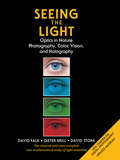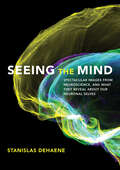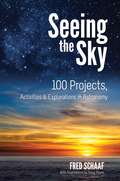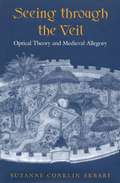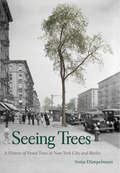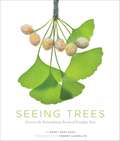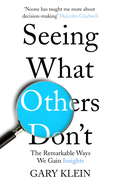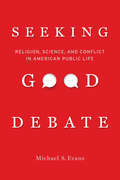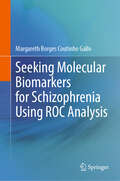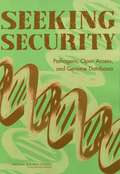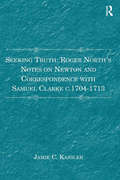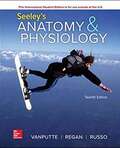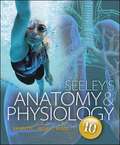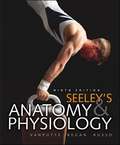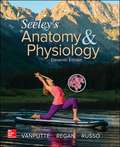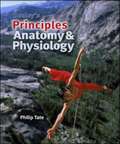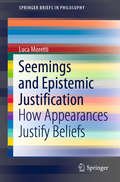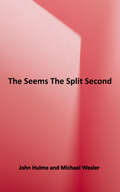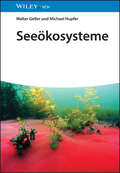- Table View
- List View
Seeing the Light: Optics in Nature, Photography, Color, Vision, and Holography (Updated Edition)
by David Falk Dieter Drill David StorkThe clearest and most complete non-mathematical study of light available—with updated material and a new chapter on digital photography. Finally, a book on the physics of light that doesn&’t require advanced mathematics to understand. Seeing the Light is the most accessible and comprehensive study of optics and light on the market. With a focus on conceptual study, Seeing the Light leaves the heavy-duty mathematics behind, instead using practical analogies and simple empirical experiments to teach the material. Each chapter is a self-contained lesson, making it easy to learn about specific optical concepts without having to read the whole book over. Inside you&’ll find clear and easy-to-understand explanations of topics including: Processes of vision and the eye Atmospherical optical phenomena Color perception and illusions Color in nature and in art Digital photography Holography And more Diagrams, photos, and illustrations help bring difficult concepts to life, and optional sections at the ends of chapters explore the more advanced aspects of each topic. A truly one-of-a-kind book for physics students and teachers, this updated edition of Seeing the Light is not to be missed.
Seeing the Mind: Spectacular Images from Neuroscience, and What They Reveal about Our Neuronal Selves
by Stanislas DehaeneA lavishly illustrated and accessibly explained deep dive into the major new findings from cognitive neuroscience.Who are we? To this age-old question, contemporary neuroscience gives a simple answer: we are exquisite neuronal machines. Each of our dreams, thoughts, and feelings arises from a pattern of activity in our brain. In Stanislas Dehaene&’s Seeing the Mind, we learn not only that the mind maps onto the brain, but that it is just a complex electrical motif on the tapestry of our neurons. In this richly illustrated and highly accessible book, Dehaene uses the power of brain images to tell the story of centuries-old efforts to understand who we are, and how it is possible that our thoughts emerge from just three pounds of flesh. Seeing the Mind is divided into one hundred topics, each described by a spectacular full-page color image and, on the facing page, a brief text that explains what this image means and why it matters. By weaving together images and text, the book brings readers into the intimacy of their own brains. As Dehaene explains, &“All the gorgeous biological processes that you are about to discover are taking place, right now, inside your own brain.&” A modern cabinet of curiosities, Seeing the Mind is an intriguing and memorable read that will astonish readers with a direct, face-to-face meeting with themselves—and with the material stuff of their thoughts and dreams.
Seeing the Sky: 100 Projects, Activities & Explorations in Astronomy (Dover Children's Science Bks.)
by Fred Schaaf Doug MyersDiscover the fascination of astronomy with 100 easy, inexpensive projects that promise loads of fun for sky watchers of all ages. Geared toward beginning astronomers from junior high school level and up, this entertaining guide was written in direct, nontechnical terms by an experienced astronomer and well-known author. Daylight and nighttime activities include sightings of comets, meteors, stars, and planets as well as phases of the Moon, halos, twilights, and many other intriguing phenomena.These interesting, instructive activities and projects require just the naked eye and ordinary household materials. In addition to a wealth of activities for families to enjoy together, Seeing the Sky also offers a fine resource for classrooms, astronomy clubs, nature societies, and other groups. This updated edition features a new Preface, two new tables, and a revised Sources of Information list that includes current websites.
Seeing the World Through Numbers (Weather and Climate (3ES))
by Andrew Falk Jeffrey EbbelerNIMAC-sourced textbook
Seeing Through the Veil
by Suzanne Conklin AkbariDuring the later Middle Ages, new optical theories were introduced that located the power of sight not in the seeing subject, but in the passive object of vision. This shift had a powerful impact not only on medieval science but also on theories of knowledge, and this changing relationship of vision and knowledge was a crucial element in late medieval religious devotion. In Seeing through the Veil, Suzanne Conklin Akbari examines several late medieval allegories in the context of contemporary paradigm shifts in scientific and philosophical theories of vision.After a survey on the genre of allegory and an overview of medieval optical theories, Akbari delves into more detailed studies of several medieval literary works, including the Roman de la Rose, Dante's Vita Nuova, Convivio, and Commedia, and Chaucer's dream visions and Canterbury Tales. The final chapter, 'Division and Darkness,' centres on the legacy of allegory in the fifteenth century. Offering a new interdisciplinary, synthetic approach to late medieval intellectual history and to major works within the medieval literary canon, Seeing through the Veil will be an essential resource to the study of medieval literature and culture, as well as philosophy, history of art, and history of science.
Seeing Trees: A History of Street Trees in New York City and Berlin (Seeing Ser.)
by Sonja DümpelmannA fascinating and beautifully illustrated volume that explains what street trees tell us about humanity’s changing relationship with nature and the city Today, cities around the globe are planting street trees to mitigate the effects of climate change. However, as landscape historian Sonja Dümpelmann explains, the planting of street trees in cities to serve specific functions is not a new phenomenon. In her eye-opening work, Dümpelmann shows how New York City and Berlin began systematically planting trees to improve the urban climate during the nineteenth century, presenting the history of the practice within its larger social, cultural, and political contexts. A unique integration of empirical research and theory, Dümpelmann’s richly illustrated work uncovers this important untold story. Street trees—variously regarded as sanitizers, nuisances, upholders of virtue, economic engines, and more—reflect the changing relationship between humans and nonhuman nature in urban environments. Offering valuable insights and frameworks, this authoritative volume will be an important resource for years to come.
Seeing Trees: Discover the Extraordinary Secrets of Everyday Trees (Seeing Series)
by Nancy Ross Hugo Robert LlewellynHave you ever looked at a tree? That may sound like a silly question, but there is so much more to notice about a tree than first meets the eye. Seeing Trees celebrates seldom seen but easily observable tree traits and invites you to watch trees with the same care and sensitivity that birdwatchers watch birds. Many people, for example, are surprised to learn that oaks and maples have flowers, much less flowers that are astonishingly beautiful when viewed up close. Focusing on widely grown trees, this captivating book describes the rewards of careful and regular tree viewing, outlines strategies for improving your observations, and describes some of the most visually interesting tree structures, including leaves, flowers, buds, leaf scars, twigs, and bark. In-depth profiles of ten familiar species—including such beloved trees as white oak, southern magnolia, white pine, and tulip poplar—show you how to recognize and understand many of their most compelling (but usually overlooked) physical features.
Seeing What Others Don't: The Remarkable Ways We Gain Insights
by Gary Klein'No one has taught me more about the complexities and mysteries of human decision-making' Malcolm Gladwell'Gary Klein is a living example of how useful applied psychology can be when it is done well' Daniel KahnemanInsight is everything. At its most profound, it can change the world. At its simplest, it can solve everyday problems. It can be used to build businesses, solve crimes, progress science and make many aspects of our lives quicker, easier, bigger or better. Yet remarkably we often unwittingly build barriers to seeing what is in front of us. Both as individuals and organisations we can hold on to flawed beliefs and conform to established processes that can interfere with our perceptions. Having clear insight can transform the way in which we understand things, the decisions we make and the actions we take.In this groundbreaking study, renowned cognitive psychologist Gary Klein uses an eclectic miscellany of real-life stories to bring to life the process of insight. He demonstrates the five key strategies for spotting connections and contractions to ensure you too can see what others don't.
Seeking Good Debate
by Michael S. EvansWhy do religion and science often appear in conflict in America's public sphere? In Seeking Good Debate, Michael S. Evans examines the results from the first-ever study to combine large-scale empirical analysis of some of our foremost religion and science debates with in-depth research into what Americans actually want in the public sphere. The surprising finding is that apparent conflicts involving religion and science reflect a more fundamental conflict between media elites and ordinary Americans over what is good debate. For elite representatives, good debate advances an agenda, but, as Evans shows, for many Americans it is defined by engagement and deliberation. This hidden conflict over what constitutes debate's proper role diminishes the possibility for science and religion to be discussed meaningfully in public life. Challenging our understanding of science, religion, and conflict, Seeking Good Debate raises profound questions about the future of the public sphere and American democracy.
Seeking Molecular Biomarkers for Schizophrenia Using ROC Analysis
by Margareth Borges Coutinho GalloSchizophrenia Spectrum Disorders (SSD) manifest multidimensionally, presenting a syndromic nature with several symptomatic domains. These are driven by dynamic systemic biological changes that unfold over the course of the disease. Thus far, the diagnosis is solely based on symptoms, which may be rather subjective, moving research toward the search for SSD biomarkers. This book presents a summary of the main hypotheses that have evolved over time to explain the pathophysiology of SSD and that have driven the discovery of associated biomarkers: neurotrophic, neurotransmitter, neuroendocrine, immune-inflammatory, nitrosative/oxidative stress, metabolic, and gut microbiota-brain axis. The book shows the most relevant research carried out in the last twelve years to develop predictive, diagnostic, theranostic or transdiagnostic models based on these biomarkers using the receiver operating characteristic curve (ROC) analysis. Chapters also discuss how the literature has addressed the development and/or addition of new discriminatory biomarkers to achieve robust and successful results. The book is rounded out with a step-by-step explanation on how to work on the MetaboAnalyst platform, including the meaning of the chosen statistics and how to interpret them in the results obtained. This book is a useful resource for students and scientists involved in the discovery of biomarkers for psychiatric disorders and other diseases.
Seeking Security: Pathogens, Open Access, and Genome Databases
by Committee on Genomics Databases for Bioterrorism Threat AgentsWithin the last 30 years, the genomes of thousands of organisms, from viruses, to bacteria, to humans, have been sequenced or partially sequenced and deposited in databases freely accessible to scientists around the world. This information is accelerating scientists' ability to fight disease and make other medical advances, but policymakers must consider the possibility that the information could also be used for destructive purposes in acts of bioterrorism or war. Based in part on views from working biological scientists, the report concludes that current policies that allow scientists and the public unrestricted access to genome data on microbial pathogens should not be changed. Because access improves our ability to fight both bioterrorism and naturally occurring infectious diseases, security against bioterrorism is better served by policies that facilitate, not limit, the free flow of this information.
Seeking Sustainable Development on a Level Playing Field: A PVC Case Study
by Mark EverardBack Cover Copy Humans have exploited a huge diversity of materials throughout history. Today’s conflict between rising demands and dwindling resources raises searching questions about how optimally to meet humanity’s needs efficiently and safely, challenging common assumptions. Plastics support many facets of modern life yet raise associated problems, whilst ‘natural’ materials may be far from benign when inputs extending their longevity are considered. PVC (polyvinyl chloride) is a plastic with adaptable, durable and other properties used in diverse construction, medical, information technology, domestic and many applications besides. However, PVC has faced significant NGO pressure relating to its chlorine content and the range of additives conferring desirable properties. Yet, unlike organochlorine pesticides, PVC plastic is inert and recyclable after providing long service life. This book is not ‘pro-PVC’, but draws on lessons learned from how the PVC value chain, particularly across Europe, has engaged with problems and made further progress under voluntary commitments to sustainable development. The book advocates a ‘level playing field’ of common sustainability principles for assessment of the benefits and risks of the use of all materials in the context of their incorporation within whole product life cycles, from raw material extraction to beyond end-of-life. The use of every material raises specific challenges, but also shares common problems arising from society’s legacy of wasteful, linear resource use. Activities surrounding the PVC value chain have generated novel ideas, assessment techniques and reconsideration of regulatory approaches relevant to sustainability assessment of the use of all materials in the context of whole product life cycles on a common ‘level playing field’, which best supports the meeting of the diversity of human needs in the safest and most efficient manner. This book is aimed at industry, regulatory and NGO audiences and influence on wider media.
Seeking the American Tropics: South Florida's Early Naturalists
by James A. KushlanFor centuries, the southernmost region of the Florida peninsula was seen by outsiders as wild and inaccessible, one of the last frontiers in the quest to understand and reveal the natural history of the continent. Seeking the American Tropics tells the stories of the explorers and adventurers who—for better and for worse—helped open the unique environment of South Florida to the world.Beginning with the arrival of Juan Ponce de León in 1513, James Kushlan describes how most of the famous Spanish explorers never made it to South Florida, leaving the area’s rich natural history out of scientific records for the next 250 years. It wasn’t until the British colonial and early American periods that the first surveyors were commissioned and the first naturalists—Titian Peale and John James Audubon—arrived to collect, draw, and report the subtropical flora and fauna that were so unique to North America.Moving into the railroad era, Kushlan illuminates the activities of scientists such as Henry Nehrling and Charles Torrey Simpson alongside the dabbling of wealthy amateur naturalists. He follows the story to the 1920s, when tourism was flourishing and signs of ecological damage were starting to show. Years of wildlife trade, resource extraction, invasive species introduction, and swamp drainage had taken their toll. And many of the naturalists who had been outspoken about protecting South Florida’s environment had also played a part in its destruction.Today the region is among one of the most thoroughly studied places on the planet—but at a cost. In this absorbing and cautionary tale, Kushlan illustrates how exploration has so often trumped conservation throughout history. He exposes how much of the natural world we have already lost in this vivid portrait of the Florida of yesterday.
Seeking Truth: Roger North's Notes On Newton And Correspondence With Samuel Clarke, C.1704-1713
by Jamie C. KasslerIn the early 1690s Roger North was preparing to remove from London to Rougham, Norfolk, where he planned to continue his search for truth, which for him meant knowledge of nature, including human nature. But this search was interrupted by three events. First, between c.1704 and the early part of 1706, he read Newton’s book on rational (quantitative) mechanics and, afterwards, his book on optics in Clarke’s Latin translation. Second, towards the latter part of 1706, he and Clarke, a Norfolk clergyman, corresponded about matters relating to Newton’s two books, after which Clarke removed to London and the correspondence ceased. Third, in 1712 North received a letter from Clarke, requesting him to read and respond to his new publication on the philosophy of the Godhead. As Kassler details, each of these events presented a number of challenges to North’s values, as well as the way of philosophising he had learned as a student and practitioner of the common law. Because he never made public his responses to the challenges, her book also includes editions of North's notes on reading Newton’s books, as well as what now remains of the 1706 and later correspondence with Clarke. In addition, she presents analyses of some of North’s ’second thoughts’ about the issues raised in the notes and 1706 correspondence and, from an examination of Clarke’s main writings, provides a context for understanding the correspondence relating to the 1712 book.
Seeking Ultimates: An Intuitive Guide to Physics, Second Edition
by Peter T. LandsbergSeeking Ultimates: An Intuitive Guide to Physics, Second Edition takes us on a journey that explores the limits of our scientific knowledge, emphasizing the gaps that are left. The book starts with everyday concepts such as temperature, and proceeds to energy, the Periodic Table, and then to more advanced ideas. The author examines the nature of ti
Seeley's Anatomy and Physiology
by Cinnamon L. VanPutteThis text is written for the two semester anatomy and physiology course. Seeley's A&P writing is comprehensive, providing the depth necessary for those courses not requiring prerequisites, and yet, is presented with such clarity that it nicely balances the thorough coverage. Clear descriptions and exceptional illustrations combine to help students develop a firm understanding of the concepts of anatomy and physiology and to teach them how to use that information. <p><p>Great care has been taken to select important concepts and to perfectly describe the anatomy of cells, organs, and organ systems. To emphasize the concepts of anatomy and physiology, the Seeley A&P authors provide explanations of how the systems respond to aging, changes in physical activity, and disease, with a special focus on homeostasis and the regulatory mechanisms that maintain it. This text has more clinical content than any other A & P book on the market.
Seeley's Anatomy And Physiology, 10th Edition
by Cinnamon Vanputte Jennifer Regan Andrew Russo Rod Seeley Trent Stephens Philip TateA Doody's Core Title for 2015! This text is written for the two semester anatomy & physiology course. The writing is comprehensive, providing the depth necessary for those courses not requiring prerequisites, and yet, is presented with such clarity that it nicely balances the thorough coverage. Clear descriptions and exceptional illustrations combine to help students develop a firm understanding of the concepts of anatomy and physiology and to teach them how to use that information. Great care has been taken to select important concepts and to perfectly describe the anatomy of cells, organs, and organ systems. The plan that has been followed for ten editions of this popular text is to combine clear and accurate descriptions of anatomy with precise explanations of how structures function and examples of how they work together to maintain life. To emphasize the concepts of anatomy and physiology, the authors provide explanations of how the systems respond to aging, changes in physical activity, and disease, with a special focus on homeostasis and the regulatory mechanisms that maintain it. This text has more clinical content than any other A & P book on the market. Users who purchase Connect Plus receive access to the full online ebook version of the textbook.
Seeley's Anatomy and Physiology (Ninth Edition)
by Cinnamon L. Vanputte Jennifer Regan Andrew Russo Rod R. SeeleyA textbook written for a two semester course on anatomy and physiology with clear illustrations, descriptions for ease in learning and understanding of the concepts in the area of study..
Seeley’s Anatomy & Physiology (Eleventh Edition)
by Cinnamon L. VanPutte Jennifer L. Regan Andrew F. Russo Rod R. SeeleyThis text is written for the two semester anatomy & physiology course. The writing is comprehensive, providing the depth necessary for those courses not requiring prerequisites, and yet, is presented with such clarity that it nicely balances the thorough coverage. Clear descriptions and exceptional illustrations combine to help students develop a firm understanding of the concepts of anatomy and physiology and to teach them how to use that information. Great care has been taken to select important concepts and to perfectly describe the anatomy of cells, organs, and organ systems. The plan that has been followed for ten editions of this popular text is to combine clear and accurate descriptions of anatomy with precise explanations of how structures function and examples of how they work together to maintain life. To emphasize the concepts of anatomy and physiology, the authors provide explanations of how the systems respond to aging, changes in physical activity, and disease, with a special focus on homeostasis and the regulatory mechanisms that maintain it. This text has more clinical content than any other A & P book on the market.
Seeley's Essentials Of Anatomy And Physiology
by Cinnamon Vanputte Jennifer Regan Andrew RussoDesigned for the one-semester course, Seeley's Essentials of Anatomy and Physiology is written to allow instructors the ability to accomplish one overall goal: to teach the basics of A&P while fostering the skill of problem solving. Through learning how to solve problems and think critically, students learn A&P based on two themes: the relationship between structure and function, and homeostasis. Users who purchase Connect Plus receive access to the full online ebook version of the textbook, as well as SmartBook.
Seeley's Principles of Anatomy and Physiology
by Philip TateThe author presents comprehensive descriptions and illustrations along with ample clinical information to help anatomy and physiology students develop a solid understanding of the concepts and how that knowledge relates to the medical world.
Seemings and Epistemic Justification: How Appearances Justify Beliefs (SpringerBriefs in Philosophy)
by Luca MorettiThis book examines phenomenal conservatism, one of the most influential and promising internalist conceptions of non-inferential justification debated in current epistemology and philosophy of mind. It also explores the significance of the findings of this examination for the general debate on epistemic justification. According to phenomenal conservatism, non-inferential justification rests on seemings or appearances, conceived of as experiences provided with propositional content. Phenomenal conservatism states that if it appears to S that P, in the absence of defeaters, S thereby has some justification for believing that P. This view provides the basis for foundationalism and many ordinary epistemic practices.This book sheds new light on phenomenal conservatism by assessing objections to it and examining epistemological merits and advantages attributed to it. In a nutshell, phenomenal conservatism is actually compatible with Bayesian reasoning, and it is unaffected by bootstrapping problems and challenges that appeal to the cognitive penetrability of perception. Nevertheless, appearance-based justification proves unstable or elusive and its anti-septical bite is more limited than expected. These difficulties could be surmounted if phenomenal conservatism were integrated with a theory of inferential justification. The book appeals to scholars and postgraduates in the field of epistemology and philosophy of mind who are interested in the rational roles of appearances.
The Seems: The Split Second: Book 2 (The\seems Ser.)
by John Hulme Michael WexlerNow thirteen years old and still a Fixer in the parallel universe called The Seems, Becker Drane is called upon to repair the damage caused by an enormous bomb planted in the Department of Time, an act of terrorism perpetrated by the evil members of The Tide, a group that is trying to destroy The World.
Seeökosysteme
by Walter Geller Michael HupferSeen sind ein zentraler Bestandteil der mitteleuropäischen Landschaften mit einem hohen Nutzwert für Wasserversorgung, Binnenfischerei, Freizeit und Artenschutz. Sie besitzen ein komplexes Ökosystem, das von vielen unterschiedlichen Faktoren wie Temperatur, Nährstoffeintrag sowie der Art und Anzahl der im See lebenden Mikroorganismen, Pflanzen und Tiere abhängt. Die Kenntnis aller dieser Faktoren und ihres Zusammenspiels ist die entscheidende Voraussetzung, um das Ökosystem See zu verstehen, zu überwachen und ggf. schützend einzugreifen, wenn dieses aus der Balance gerät. Diese umfassende Übersicht zur Ökologie von Seen basiert auf neuesten Erkenntnissen und zahlreichen wissenschaftlichen Studien aus den vergangenen zwei Jahrzehnten. Zunächst werden die abiotischen Faktoren wie Temperatur, Licht und Sauerstoffverhältnisse und deren Einfluss auf die Gliederung von Seen in unterschiedliche Habitate und ökologische Nischen beschrieben. Weitere Kapitel befassen sich mit den Organismen im See, vom Phytoplankton und Zooplankton bis hin zu höheren Pflanzen und Tieren, deren Populationsbiologie, sowie den daraus entstehenden ökologischen Netzen. Der Einfluss invasiver Arten wird anhand von mehreren Beispielen dokumentiert. Dieses Standardwerk zur Ökologie von Seen erklärt und dokumentiert anhand von umfangreichem Datenmaterial den Stand des Wissens und ist ein zuverlässiger Begleiter für Ausbildung und Beruf.

